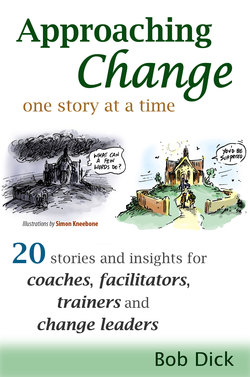Читать книгу Approaching Change One Story At a Time: 20 Stories and Insights for Coaches, Facilitators, Trainers and Change Leaders - Bob Dick - Страница 7
На сайте Литреса книга снята с продажи.
The dirty coffee cup system
ОглавлениеIn the 1960s the credit card system was much less organised and much more cutthroat than it is now. Dee Hock, a young bank vice president was asked to recommend what could be done about it. His recommendation was to develop a single cooperative credit card company that would offer a 24-hour service globally.
His bank gave him permission to proceed, but within a tight budget and timeline.
He hired a consultant to develop a plan, budget and timeline for the task. The consultant estimated that it would exceed the budget. Not only that: it wouldn’t be completed within the allotted time.
Undiscouraged, Dee assembled a group of volunteers and rented space in a suburban building. A long wall within the building became their planning wall. A sequence of dates along the top of the wall defined their timeline.
The team identified the required tasks and wrote them and their necessary completion dates on scraps of paper. They arranged the scraps of paper in sequence at the appropriate date on the planning wall. They then had in front of them an overall view of the tasks, their sequence, and their completion dates.
People volunteered to take on tasks. When they did so they wrote their name on the relevant scrap of paper.
As people worked on developing the plan, anyone could modify a task with the agreement of others affected. As needs emerged, people met in small groups in front of the planning wall. As a need was met they disbanded and moved on to other tasks. When a task was completed its scrap of paper was removed from the wall.
Someone found a dirty coffee cup and used a length of grimy string to suspend it on the wall at the current date. Each day it would be moved forward one space. “Inexorably”, Dee Hock said. Time was short and the consultant had predicted the task couldn’t be completed on time.
In such a complex situation it was no disgrace for a task to fall behind schedule — it could happen to anyone. From time to time a task would be left behind when the coffee cup and string moved. Volunteers then gathered to decide how to complete the errant task. People willingly offered or accepted help in the interests of the overall project. Commitment to the collective task was strong.
People exercised leadership as it was required, and relinquished it when it wasn’t. When ingenuity was necessary it happened. No one was in control, Dee Hock claims. The climate was one of excitement.
Day by day the string moved on. One by one the tasks were completed. As Dee Hock describes the situation, “a community based on purpose, principle and people arose” and “individuality, self-worth, ingenuity and creativity flourished”.
He called it a “chaord”, a social unit sitting at the margin between order and chaos. Today we’d call it a self-organising system. We’d expect it to be a place of creativity and enthusiasm, as it was.
Some participants did find the mix of chaos and order too disturbing. When they left, as they did, there was no problem. Others volunteered enthusiastically to take their place.
Dee Hock notes that the string remained grimy, and the cup unwashed. The “Dirty Coffee Cup System”, as it was known, set the tone for the global Visa communication system that was being designed. It became a metaphor for the company that they wished to create.
The plan for the communication system was completed. Not only that, it was completed on time. It exceeded objectives. It was under budget.
Events are richer, generally, than any story about them can hope to capture. Stories are a selection, giving attention to some parts of the story at the expense of other parts. When reading a story, a question I can ask myself is, “What’s missing?”
For me, the dirty coffee cup story omits one piece of information that I would have found interesting and instructive. Did it all just happen?
Dee Hock describes creativity and engagement. When the building was hired and the team recruited, did the creativity and engagement blossom forth immediately? Or did it require some effort on his part before it did? He doesn’t tell us.
I do know from the next story that he wasn’t averse to intervening. That will become clear as you read his story about the golden cufflinks. Sometimes he didn’t leave events to chance. He acted to shape them. I’d really like to know if he also helped to create the enthusiasm of his chaordic planning team.
My own experience in a university classroom, imparted later, addresses that question. When we come to it you’ll observe that it took me several years of trial and error to create an environment where engagement and enthusiasm were usual.
With that thought, enjoy the story of the golden cufflinks.
